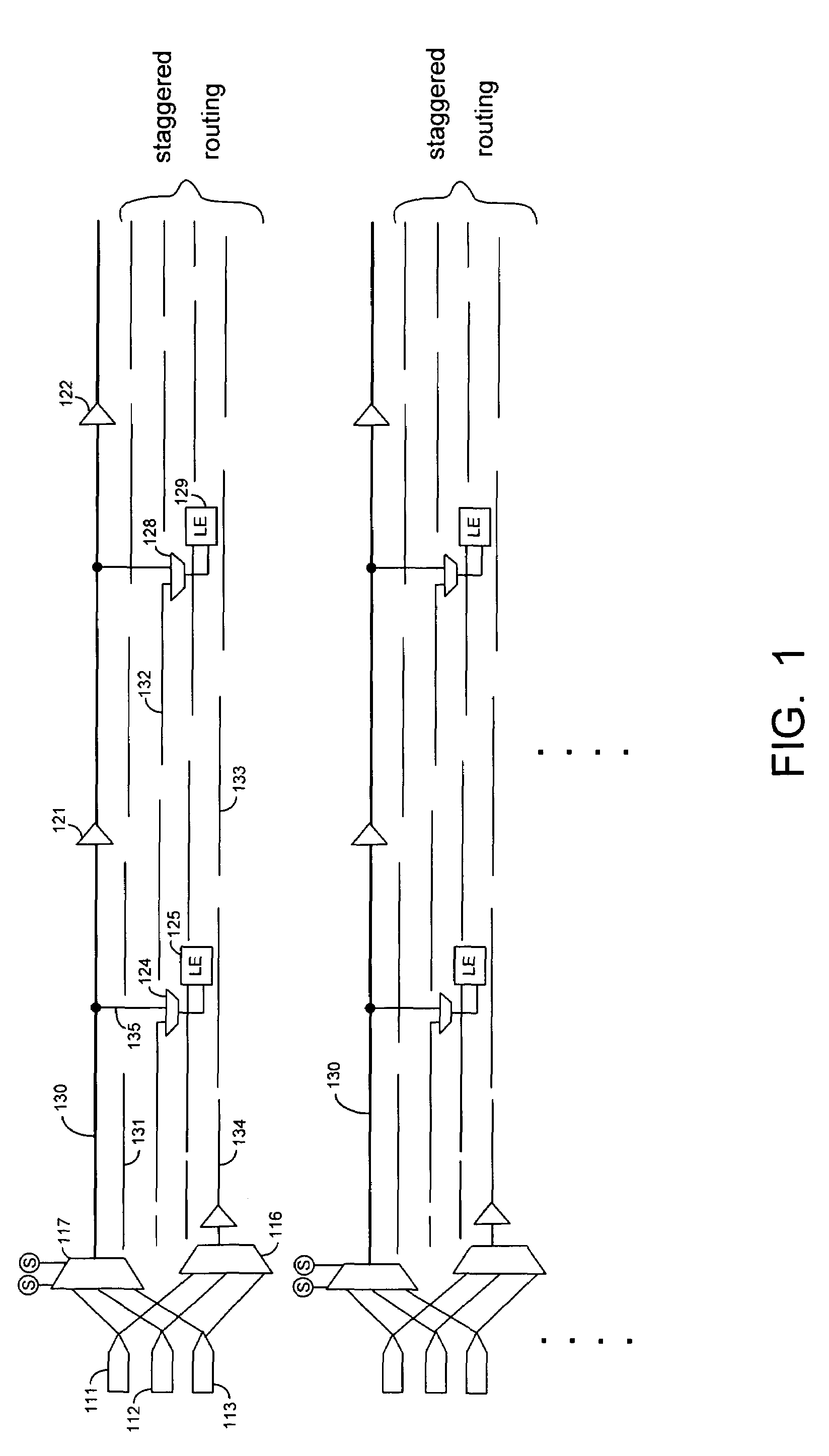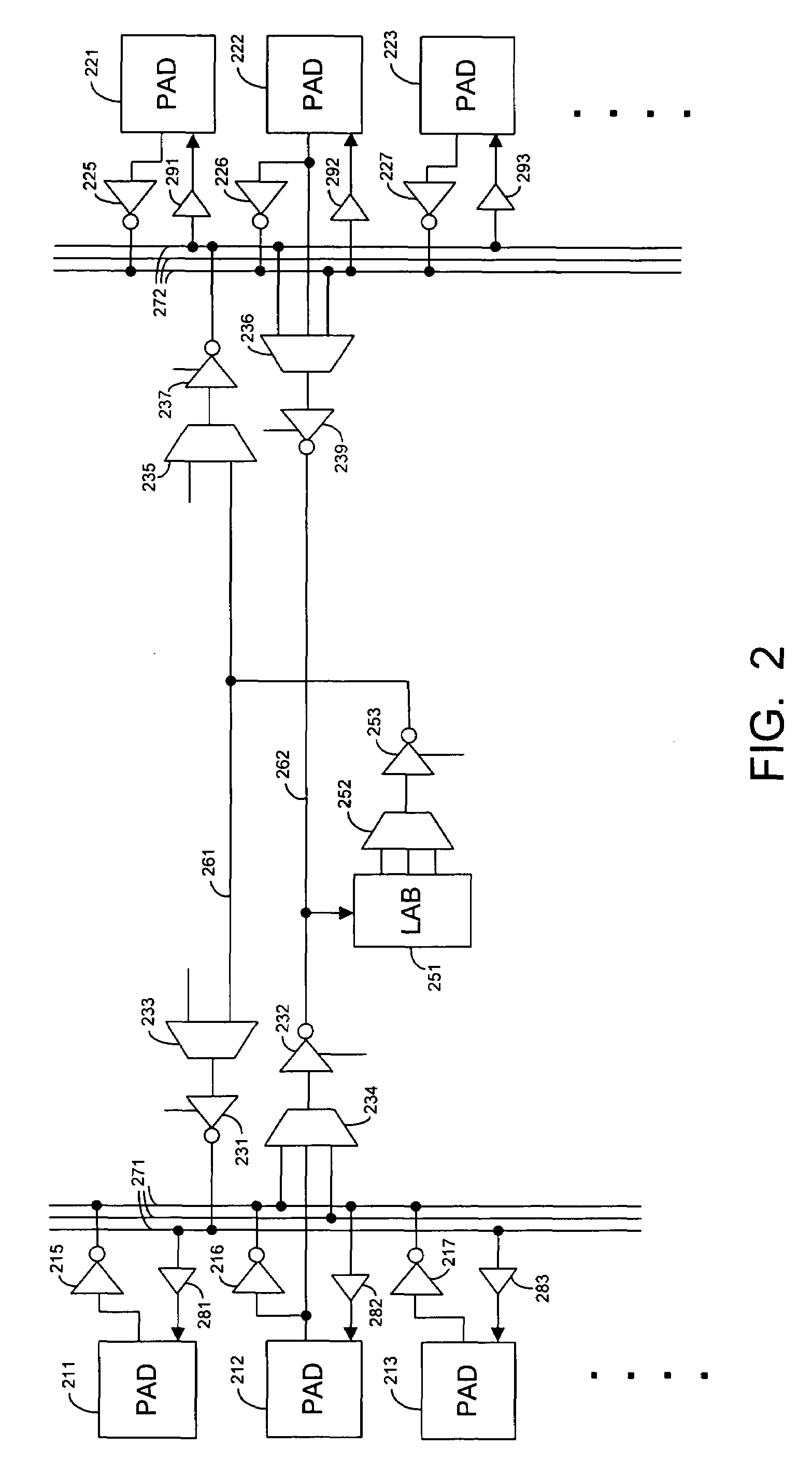Programmable routing structures providing shorter timing delays for input/output signals
- Summary
- Abstract
- Description
- Claims
- Application Information
AI Technical Summary
Benefits of technology
Problems solved by technology
Method used
Image
Examples
first embodiment
[0017]FIG. 1 illustrates a dedicated input routing structure according to the present invention. Programmable horizontal routing conductors 130 are dedicated for transmitting signals from input pads of a programmable logic integrated circuit (IC). Input pads 111, 112, and 113 are examples of input pads on the IC.
[0018]Input signals applied to any of pads 111–113 can be driven to one of routing conductors 130 through 3:1 multiplexer 117. Multiplexer 117 couples conductor 130 to one of pads 111–113 in response to the states of two select signals. The select signals (shown as S in FIG. 1) are stored in memory. Signals driven along line 130 are amplified by buffers 121 and 122. Buffers 121 and 122 (and other buffers) can be inverting or non-inverting buffers.
[0019]The programmable logic integrated circuit includes staggered horizontal routing conductors such as conductors 131, 132, 133, and 134 shown in FIG. 1. The staggered routing conductors can include local and segmented conductors....
second embodiment
[0022]FIG. 2 illustrates a dedicated I / O routing structure according to the present invention. FIG. 2 illustrates a portion of a programmable logic IC. The IC includes vertical routing conductors 271–272 and horizontal routing conductors 261–262 that are dedicated for routing signals to and from I / O pads such as pads 211–213 and 221–223. Although a limited number of dedicated I / O routing conductors are shown in FIG. 2, embodiments of the present invention can include any number of vertical and horizontal dedicated I / O routing conductors arranged in any suitable configuration.
[0023]Input signals applied to pads 211–213 are driven to dedicated I / O conductors 271 through inverting buffers 215–217, respectively. One of conductors 271 can be programmably coupled to horizontal conductor 262 through multiplexer 234 and tristate driver 232. Also, an input signal applied to pad 212 can be driven directly to conductor 262 through multiplexer 234 without being routed through one of conductors ...
third embodiment
[0034]FIG. 3 illustrates another dedicated I / O routing structure according to the present invention. The embodiment of FIG. 3 also has a limited number of dedicated I / O conductors. The dedicated I / O routing structure of FIG. 3 includes vertical conductors 331–333 and 371–373 and horizontal conductors 391–398.
[0035]Input signals applied to I / O pads 311–313 can be routed to vertical conductors 331–333 as will now be discussed. 2:1 multiplexers 321–323 are controlled by RAM bits that are transmitted to select inputs (not shown) of the multiplexers. Each multiplexer 321–323 has two inputs coupled to two pads and a single output coupled to one of conductors 331–333. Tristate drivers 341–343 are coupled between the output of multiplexers 321–323 and conductors 331–333, respectively.
[0036]An input signal applied to a particular I / O pad can be driven to one or two (but not three) of conductors 331–333. For example, an input signal applied to pad 311 can be driven to conductor 331 through mu...
PUM
 Login to View More
Login to View More Abstract
Description
Claims
Application Information
 Login to View More
Login to View More - R&D
- Intellectual Property
- Life Sciences
- Materials
- Tech Scout
- Unparalleled Data Quality
- Higher Quality Content
- 60% Fewer Hallucinations
Browse by: Latest US Patents, China's latest patents, Technical Efficacy Thesaurus, Application Domain, Technology Topic, Popular Technical Reports.
© 2025 PatSnap. All rights reserved.Legal|Privacy policy|Modern Slavery Act Transparency Statement|Sitemap|About US| Contact US: help@patsnap.com



